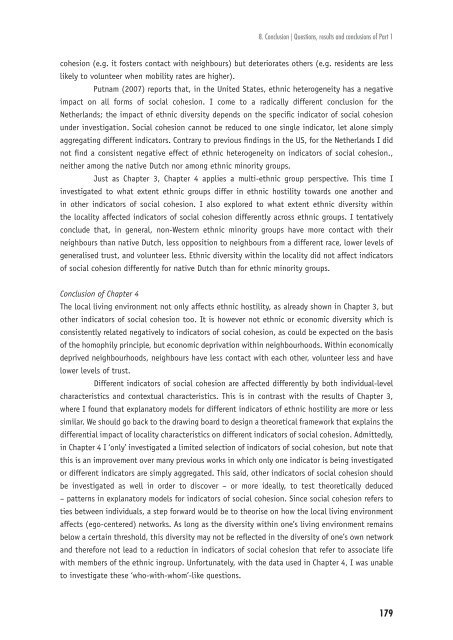Ethnic Hostility among Ethnic Majority and Minority Groups
Ethnic Hostility among Ethnic Majority and Minority Groups
Ethnic Hostility among Ethnic Majority and Minority Groups
Create successful ePaper yourself
Turn your PDF publications into a flip-book with our unique Google optimized e-Paper software.
8. Conclusion | Questions, results <strong>and</strong> conclusions of Part 1<br />
cohesion (e.g. it fosters contact with neighbours) but deteriorates others (e.g. residents are less<br />
likely to volunteer when mobility rates are higher).<br />
Putnam (2007) reports that, in the United States, ethnic heterogeneity has a negative<br />
impact on all forms of social cohesion. I come to a radically different conclusion for the<br />
Netherl<strong>and</strong>s; the impact of ethnic diversity depends on the specifi c indicator of social cohesion<br />
under investigation. Social cohesion cannot be reduced to one single indicator, let alone simply<br />
aggregating different indicators. Contrary to previous fi ndings in the US, for the Netherl<strong>and</strong>s I did<br />
not fi nd a consistent negative effect of ethnic heterogeneity on indicators of social cohesion.,<br />
neither <strong>among</strong> the native Dutch nor <strong>among</strong> ethnic minority groups.<br />
Just as Chapter 3, Chapter 4 applies a multi-ethnic group perspective. This time I<br />
investigated to what extent ethnic groups differ in ethnic hostility towards one another <strong>and</strong><br />
in other indicators of social cohesion. I also explored to what extent ethnic diversity within<br />
the locality affected indicators of social cohesion differently across ethnic groups. I tentatively<br />
conclude that, in general, non-Western ethnic minority groups have more contact with their<br />
neighbours than native Dutch, less opposition to neighbours from a different race, lower levels of<br />
generalised trust, <strong>and</strong> volunteer less. <strong>Ethnic</strong> diversity within the locality did not affect indicators<br />
of social cohesion differently for native Dutch than for ethnic minority groups.<br />
Conclusion of Chapter 4<br />
The local living environment not only affects ethnic hostility, as already shown in Chapter 3, but<br />
other indicators of social cohesion too. It is however not ethnic or economic diversity which is<br />
consistently related negatively to indicators of social cohesion, as could be expected on the basis<br />
of the homophily principle, but economic deprivation within neighbourhoods. Within economically<br />
deprived neighbourhoods, neighbours have less contact with each other, volunteer less <strong>and</strong> have<br />
lower levels of trust.<br />
Different indicators of social cohesion are affected differently by both individual-level<br />
characteristics <strong>and</strong> contextual characteristics. This is in contrast with the results of Chapter 3,<br />
where I found that explanatory models for different indicators of ethnic hostility are more or less<br />
similar. We should go back to the drawing board to design a theoretical framework that explains the<br />
differential impact of locality characteristics on different indicators of social cohesion. Admittedly,<br />
in Chapter 4 I ‘only’ investigated a limited selection of indicators of social cohesion, but note that<br />
this is an improvement over many previous works in which only one indicator is being investigated<br />
or different indicators are simply aggregated. This said, other indicators of social cohesion should<br />
be investigated as well in order to discover – or more ideally, to test theoretically deduced<br />
– patterns in explanatory models for indicators of social cohesion. Since social cohesion refers to<br />
ties between individuals, a step forward would be to theorise on how the local living environment<br />
affects (ego-centered) networks. As long as the diversity within one’s living environment remains<br />
below a certain threshold, this diversity may not be refl ected in the diversity of one’s own network<br />
<strong>and</strong> therefore not lead to a reduction in indicators of social cohesion that refer to associate life<br />
with members of the ethnic ingroup. Unfortunately, with the data used in Chapter 4, I was unable<br />
to investigate these ‘who-with-whom’-like questions.<br />
179












